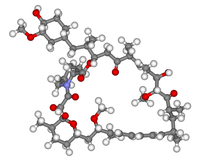
Photo from wikipedia
INTRODUCTION The mammalian target of rapamycin (mTOR) pathway is up-regulated in prostate cancer (PCa). We evaluated the tumor tissue expression of downstream mTOR targets in patients with intermediate- and high-risk… Click to show full abstract
INTRODUCTION The mammalian target of rapamycin (mTOR) pathway is up-regulated in prostate cancer (PCa). We evaluated the tumor tissue expression of downstream mTOR targets in patients with intermediate- and high-risk (IR/HR) PCa and their ability to predict outcome after radical prostatectomy (RP). PATIENTS AND METHODS Immunohistochemical (IHC) analysis using antibodies against PTEN, mTOR, p-mTOR, pAKT, pS6, and Ki-67 was performed on a tissue microarray constructed from formalin-fixed paraffin-embedded RP specimens. The marker expression was analyzed to determine their predictability for biochemical recurrence (BCR). RESULTS Tumor tissue from 217 patients (86 IR/131 HR) was analyzed. The most frequent markers were p-mTOR, which was expressed in most cases (85%), whereas PTEN and pS6 were detected in 53% and 40% of the cases, respectively. Overexpression of PTEN (P = .02) and pS6 (P < .001) was associated with HR features. With a median follow up of 13.5 years, 39% (77/196) of patients developed BCR after RP, more frequently (31%) in patients with HR disease (P < .001). Overexpression of pS6 (P = .036), Ki67% (P = .024), and lack of expression of mTOR (P = .021) were associated with BCR. The 5- and 10-year survival rate was 81% and 66%, respectively. CONCLUSIONS Protein expression of downstream mTOR molecules was significantly associated with outcome of patients with IR and HR PCa. Markers of the mTOR pathway could be incorporated in clinical studies evaluating inhibitors of the signaling pathway for treatment selection in men with PCa.
Journal Title: Clinical genitourinary cancer
Year Published: 2019
Link to full text (if available)
Share on Social Media: Sign Up to like & get
recommendations!